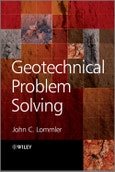The scope of material covered includes a range of geotechnical topics, such as soil classification, soil stresses and strength and soil self-weight settlement. Shallow and deep foundations are analyzed, including special articles on laterally loaded piles, retaining structures including MSE and Tieback walls, slope and trench stability for natural, cut and fill slopes, geotechnical uncertainty, and geotechnical LRFD (Load and Resistance Factor Design).
Table of Contents
Preface vii1 General Topics 1
1.1 How to Use This Book 2
1.2 You have to See It to Solve It 5
1.3 My Approach to Modern Geotechnical Engineering Practice – An Overview 12
1.4 Mistakes or Errors 26
2 Geotechnical Topics 35
2.1 Soil Classification – Why DoWe Have It? 36
2.2 Soil Stresses and Strains 61
2.3 Soil Shear Strength 73
2.4 Shear Strength Testing – What is Wrong with the Direct Shear Test? 84
2.5 What is the Steady State Line? 94
2.6 Static Equilibrium and Limit States 105
2.7 Unsaturated Soils 110
3 Foundations 127
3.1 Settlements of Clays 128
3.2 Settlements of Sands 139
3.3 Self-Weight Settlement of Sandy Soils 161
3.4 Bearing Capacity of Shallow Foundations 169
3.5 Load Capacity of Deep Foundations 179
3.6 Laterally Loaded Piles and Shafts 205
4 Retaining Structures – Lateral Loads 221
4.1 Lateral Earth Pressure 222
4.2 Retaining Walls – Gravity, Cantilevered, MSE, Sheet Piles, and Soldier Piles 234
4.3 Tieback Walls 255
5 Geotechnical LRFD 267
5.1 Reliability, Uncertainty and Geo-Statistics 268
5.2 Geotechnical Load and Resistance Factor Design 278
5.3 LRFD Spread Footings 282
5.4 LRFD Pile Foundations 295
5.5 LRFD Drilled-Shaft Foundations 303
5.6 LRFD Slope Stability 312
6 Closing 321
6.1 The Big Picture 322
6.2 V and V and Balance 327
6.3 The Biggest Problem 330
6.4 Topics Left for Later 332
Index 335
Samples

LOADING...








